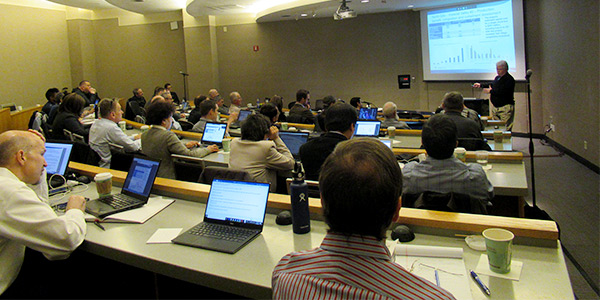By Hudson Sangree
SALT LAKE CITY — CAISO is exploring ways to exchange more low-carbon electricity with the Pacific Northwest, while WestConnect is looking to absorb exports from California during times of CAISO overgeneration, speakers said Tuesday at the Western Planning Regions Annual Interregional Coordination Meeting.
WestConnect’s CAISO Export Stress Study is intended to “test the robustness of the WestConnect transmission system in a [scenario of] high California export into the WestConnect footprint,” said Charlie Reinhold, project manager with WestConnect, which oversees transmission planning in Arizona, New Mexico, Colorado and several other Western states.
The Feb. 19 meeting brought together stakeholders and representatives of CAISO, ColumbiaGrid, Northern Tier Transmission Group (NTTG) and WestConnect to discuss interregional coordination under FERC Order 1000. The order requires transmission providers to participate in a planning process that identifies the most cost-effective solutions to transmission needs and to allocate costs based on estimated benefits.
No regional transmission needs under Order 1000 were identified in the current planning cycle, but several studies are underway in response to California’s ambitious clean-energy goals. The state enacted a new law last year, SB 100, that requires investor-owned utilities, publicly owned utilities and community choice aggregators to obtain 100% of their energy from renewable and zero-carbon resources by 2045.
The new law sets renewable milestones along the way: 40-44% by 2024, 45-52% by 2027, and 50-60% by 2030. That means California will have to import more clean electricity, and export solar energy when it’s generating too much, in the coming years. (See Can Calif. Go All Green Without a Western RTO?)
At the same time, natural gas generation, the state’s main fossil-fuel source of electricity, is expected to gradually disappear.
CAISO embarked on its study of north-to-south transmission after it received a letter in February 2018 from the California Public Utilities Commission and California Energy Commission asking it for help in planning for transmission needs as the hobbled Aliso Canyon natural gas storage facility near Los Angeles is phased out in the next 10 years and the state’s gas generation diminishes.
“Phasing out Aliso Canyon usage and potential impacts on the gas-fired generation fleet need to be considered from the perspective of reliability of electricity supply to southern California more generally and the Los Angeles Basin in particular, as well as the role those resources play in providing adequate system capacity and flexibility overall,” CEC Chairman Robert B. Weisenmiller and CPUC President Michael Picker wrote to CAISO CEO Steve Berberich.
At the interregional planning meeting, Gary DeShazo, regional coordination director at CAISO, said the ISO has a close working relationship with the PUC and CEC, which provides CAISO with renewable portfolio standards and load information.
“We do a transmission plan with that information in our base case,” DeShazo said.
“They’ve looked at it from the point of view of what does it take to meet the state’s greenhouse gas goals?” he added.
In the joint letter, the PUC and Energy Commission told CAISO: “Expanded transmission capability is an important option available to us. Clearly, increasing the transfer of low-carbon supplies to and from the Northwest can be one of the multiple puzzle pieces that we must examine to build a cumulative phase out strategy.”
“Toward this end, we are requesting a specific sensitivity case be included in the 2018- 2019 California ISO transmission planning process (TPP),” Weisenmiller and Picker wrote. “It is time-critical that we act now to evaluate key options to increase transfer ratings of the AC and DC Intertie and assess what role these systems can play in displacing generation whose reliability is tied to Aliso Canyon.”
Ebrahim Rahimi, CAISO’s lead regional transmission engineer, said the effort, called the Pacific Northwest-California Transfer Increase Informational Special Study, involves increasing transfer capacities without major system upgrades, primarily on the main AC and DC interties linking the Columbia River basin to Los Angeles — and thereby the Pacific Northwest to the desert Southwest.
The retirement of California’s last nuclear generating station, PG&E’s Diablo Canyon Power Plant on the central California coast, will ease congestion on existing pathways, Rahimi said. CAISO is also examining whether NERC and WECC might relax their standards on the physical separation of high-voltage transmission lines.






